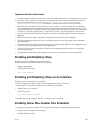
Configuring SNMP version 3 requires configuring SNMP users in one of three methods. Refer to Setting
Up User-Based Security (SNMPv3).
Related Configuration Tasks
• Managing Overload on Startup
• Reading Managed Object Values
• Writing Managed Object Values
• Subscribing to Managed Object Value Updates using SNMP
• Copying Configuration Files via SNMP
• Manage VLANs Using SNMP
• Enabling and Disabling a Port using SNMP
• Fetch Dynamic MAC Entries using SNMP
• Deriving Interface Indices
• Monitor Port-channels
Important Points to Remember
• Typically, 5-second timeout and 3-second retry values on an SNMP server are sufficient for both LAN
and WAN applications. If you experience a timeout with these values, increase the timeout value to
greater than 3 seconds, and increase the retry value to greater than 2 seconds on your SNMP server.
• User ACLs override group ACLs.
Set up SNMP
The Dell Networking OS supports SNMP version 1 and version 2 that are community-based security
models.
The primary difference between the two versions is that version 2 supports two additional protocol
operations (informs operation and snmpgetbulk query) and one additional object (counter64 object).
SNMP version 3 (SNMPv3) is a user-based security model that provides password authentication for user
security and encryption for data security and privacy. Three sets of configurations are available for SNMP
read/write operations: no password or privacy, password privileges, password and privacy privileges.
You can configure a maximum of 32 users even if they are in different groups.
Creating a Community
For SNMPv1 and SNMPv2, create a community to enable the community-based security on the switch.
The management station generates requests to either retrieve or alter the value of a management object
and is called the SNMP manager. A network element that processes SNMP requests is called an SNMP
agent. An SNMP community is a group of SNMP agents and managers that are allowed to interact.
Communities are necessary to secure communication between SNMP managers and agents; SNMP
agents do not respond to requests from management stations that are not part of the community.
The system enables SNMP automatically when you create an SNMP community and displays the
following message. You must specify whether members of the community may only retrieve values
(read), or retrieve and alter values (read-write).
22:31:23: %SYSTEM-P:CP %SNMP-6-SNMP_WARM_START: Agent Initialized - SNMP
WARM_START.
Simple Network Management Protocol (SNMP)
845


















